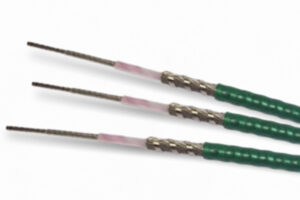Versatile Motion Control with Superior Protection
Conduit and innermember form the backbone of control cable assemblies used in a variety of motion control applications. Conduit serves as a protective and guiding sheath for the innermember and often has a smooth inner liner to reduce friction and wear, and may also include features like strands or a binding wire to prevent snagging and outer sheaths for additional protection. Innermember is housed in the conduit, allowing it to move back and forth or rotate within the conduit’s confines, and may be a wire, rope, or other flexible element designed to transmit force or motion.

Flexibility, Efficiency, Low Backlash
Cablecraft’s wide selection of conduit and innermember has evolved from over 75 years of experience in meeting a wide variety of motion control applications and offer superior flexibility, high efficiency, low backlash and minimum bend radius.
Combining careful selection of materials with proprietary in-house fabrication methods, Cablecraft conduit and innermember provides users with the most versatile, highest quality motion control with superior protection from contaminants and damage.
Key Benefits:
- Galvanized or stainless-steel armor-wrapped innermember uses 1×19 base strand, which allows for maximum flexibility and minimum bend radius vs typical 1×7 or 1×13 construction
- High-temp materials allow for 350°F+ continuous operation
- Innermember and conduit are closely matched to maintain low backlash for high-performance applications
- PTFE and other low-friction materials are used to meet high-performance efficiency requirements
- Proprietary binder wire design allows for maximum flexibility and minimum bend radius down to 2”
- Conduit strand optimized with galvanized or stainless steel to withstand harsh operating environments
- Plastic coating to selected to enhance life cycle, resist abrasion, and seal out contaminants
Applications:
- Fight controls
- Helicopter controls
- Seating
- Door release
Engineering Resources & Design Guides
Our engineering team has applied their years of industry experience to develop resource documentation for each of our product lines.
Cable Assembly Network
Our Worldwide Cable Assembler Network can help you with your mechanical motion control solutions.
Online Catalog
Don’t need a custom design? Download our digital catalog to see all of our available cable and linkage assemblies.
Conduit & Innermember Design Considerations
- Minimum Bend Radius: The smallest radius a cable can conform to without kinking it, damaging it, or reducing its life. The smaller the bend radius, the more flexible the material must be.
- Backlash: Motion lost between the input end and the output end which is due to factors including the amount of clearance between the conduit and innermember.
- Efficiency: Amount of force lost between the input load and the output load is due to factors including friction. As efficiency decreases, the cable becomes more difficult to operate.
- Length: As length increases, cable efficiency may decrease.
- Loads: Cables have limited load capacities. Proper selection of cable capability / size to load requirements will enhance life and performance.
- Environment: Factors such as temperature, moisture, dirt/contamination can significantly affect cable performance and life.
- Degrees of Bend: The total amount of bend in a cable’s installed configuration. Increasing degrees of bend will increase lost motion and can reduce efficiency.
Industries
Conduit and innermember are used within the following industries:
Engineering Resources
Considerations When Choosing the Proper Conduit Cable For Your Application
Engineering Resources & Design Guides
Our engineering team has applied their years of industry experience to develop resource documentation for each of our product lines.
Cable Assembly Network
Our Worldwide Cable Assembler Network can help you with your mechanical motion control solutions.
Online Catalog
Don’t need a custom design? Download our digital catalog to see all of our available cable and linkage assemblies.





